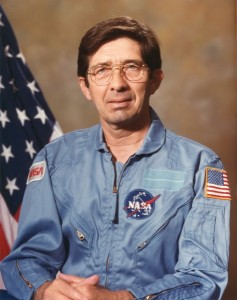 Lodewijk van den Berg paused a moment before articulating the surreal sensation of working in zero gravity. “It’s very difficult to imagine if you haven’t experienced it,” he said. “All of a sudden, you’re not standing with your two legs on the ground. You lose your center. You lose your orientation. There is no longer any difference between up and down and left and right.”
Lodewijk van den Berg paused a moment before articulating the surreal sensation of working in zero gravity. “It’s very difficult to imagine if you haven’t experienced it,” he said. “All of a sudden, you’re not standing with your two legs on the ground. You lose your center. You lose your orientation. There is no longer any difference between up and down and left and right.”
The world’s first Dutch-born astronaut, van den Berg spoke Thursday in the Wishnick Hall Auditorium with IIT students and faculty about his time aboard the Space Shuttle Challenger as a payload specialist researching crystal growth.
Sponsored by the IIT Armour College of Engineering, van den Berg used his presentation to enumerate all aspects of the 1985 STS-51-B mission, starting with NASA’s rigorous astronaut selection process.
Van den Berg’s name was added to the list of potential astronauts almost as an afterthought, given that he had poor eyesight and was 53 years old at the time. But after successfully completing a 452-part questionnaire and a grueling, three-day physical evaluation, van den Berg, a chemical engineer, became one of NASA’s seven primary candidates.
Weeks of training followed, he said, a good portion of which centered on habituating the astronauts to living in a strictly confined space for an entire week. “It took a while to adjust,” he noted.
Van den Berg then discussed the various components that comprised the spacecraft and described the launch. With a video of the STS-51-B crew playing in the background, he spoke about the daily minutiae of living and working in space, including the logistics of eating, sleeping and performing experiments in zero gravity. “You can eat soup with a fork,” he said. “You can lift a 300-pound piece of equipment with one hand.”
Regarding the experiments and upkeep of the ship, van den Berg said NASA pre-planned everything. “Your free will goes out the window,” he said. “NASA will give you instructions like, ‘On day five at 13 hours and 10 minutes and 16 seconds, tighten this screw.’ And after you’re done tightening that screw, you don’t touch or do anything else until given further instructions.”
Van den Berg rounded off his presentation by detailing the re-entry of the Challenger and taking questions from attendees, many of whom wanted further details about NASA’s selection process and the practicalities of performing every-day tasks in space. What, one attendee asked, do you do if you need to sneeze in zero gravity? “You grab something and hold on for dear life,” Van den Berg said.
